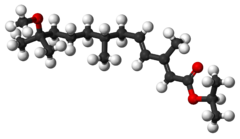- Methoprene
-
Methoprene[1] 
 1-methylethyl (E,E)-11- methoxy-3,7,11-trimethyl- 2,4-dodecadienoateOther namesMethoprene, Altosid, Apex, Diacan, Dianex, Kabat, Minex, Pharorid, Precor, ZR-515
1-methylethyl (E,E)-11- methoxy-3,7,11-trimethyl- 2,4-dodecadienoateOther namesMethoprene, Altosid, Apex, Diacan, Dianex, Kabat, Minex, Pharorid, Precor, ZR-515Identifiers CAS number 40596-69-8 
PubChem 5366546 KEGG C14308 
ATCvet code QP53 Jmol-3D images Image 1 - CC(C)(OC)CCCC(C)C/C=C/C (C)=C/C(OC(C)C)=O
Properties Molecular formula C19H34O3 Molar mass 310.48 g/mol Appearance Liquid Boiling point 100 °C at 0.05 mmHg
 (verify) (what is:
(verify) (what is:  /
/ ?)
?)
Except where noted otherwise, data are given for materials in their standard state (at 25 °C, 100 kPa)Infobox references Methoprene is a juvenile hormone (JH) analog which can be used as an insecticide that acts as a growth regulator. Methoprene is an amber-colored liquid with a faint fruity odor which is essentially nontoxic to humans when ingested or inhaled. It is used in drinking water cisterns to control mosquitoes which spread dengue fever and malaria.[2]
Methoprene does not kill adult insects. Instead, it acts as a growth regulator, mimicking natural juvenile hormone of insects. Juvenile hormone must be absent for a pupa to molt to an adult, so methoprene treated larvae will be unable to successfully change from a pupa to the adult insect. This breaks the biological life cycle of the insect preventing recurring infestation. "Methoprene is used in the production of a number of foods including meat, milk, mushrooms, peanuts, rice and cereals. It also has several uses on domestic animals (pets) for controlling fleas. Methoprene is considered a biochemical pesticide because rather than controlling target pests through direct toxicity, methoprene interferes with an insect’s life cycle and prevents it from reaching maturity or reproducing."[3] Methoprene is used most widely as the mosquito larvicide Altosid, which is an important measure in prevention of West Nile virus.
It is one of two active ingredients (the other being fipronil) in Frontline Plus, a product for dogs and cats that kills fleas, flea eggs, and ticks.
Methoprene is also used as a food additive in cattle feed. This is done to prevent fly breeding in the dung piles, which is a form of biocontrol.
It has been suggested that methoprene is responsible for killing and stunting the growth of lobsters in Narragansett Bay.[4] The real life relevance of this is questioned by some,[neutrality is disputed] because methoprene is not used in the open ocean or near beaches[citation needed]. However, considering the durability of the chemical in the environment (approximately two days), the lasting effect of the biological activity of the substance in the environment (about one week), it should be further investigated. [5] These timelines, coupled with the fact that there is runoff of fresh surface waters into the ocean from inland areas, suggest that it is very possible or likely that methoprene enters the ocean ecosystem in an active form. Studies would have to be conducted to test the hypothesis that methoprene interferes with the life cycle of lobsters before a conclusive position can be reached on the effects of Methoprene on the lobster fishery.
References
- ^ Merck Index, 11th Edition, 5906.
- ^ "Methoprene". Water Sanitation and Health. World Health Organization. http://www.who.int/water_sanitation_health/dwq/chemicals/methoprenesum_2ndadd.pdf. Retrieved 2008.
- ^ "Insect Growth Regulators: S-Hydroprene (128966), S-Kinoprene (107502), Methoprene (105401), S-Methoprene (105402) Fact Sheet". U.S. Environmental Protection Agency. http://www.epa.gov/oppbppd1/biopesticides/ingredients/factsheets/factsheet_igr.htm. Retrieved 2007-09-09.
- ^ "Are our lobsters casualties in war on mosquitoes?". http://www.projo.com/news/content/pesticide_vs_lobsters_06-17-08_1FADP78_v34.3e92bf0.html. Retrieved 2008-07-18.
- ^ "Studies On The Dissipation of Diflubenzuron and Methoprene From Shallow Prairie Pools". http://pubs.esc-sec.ca/doi/abs/10.4039/Ent112173-2. Retrieved 2011-10-25.
External links
- Methoprene Pesticide Fact Sheet - Environmental Protection Agency
- Methoprene Pesticide Information Profile - Extension Toxicology Network
Categories:- Insecticides
- Carboxylate esters
- Ethers
- Dienes
Wikimedia Foundation. 2010.
